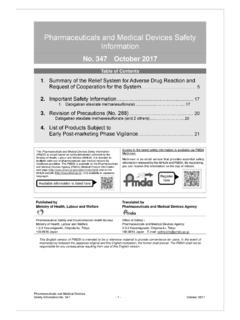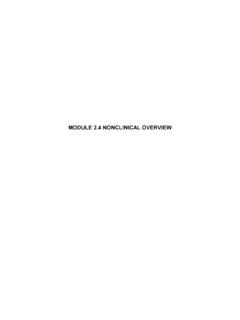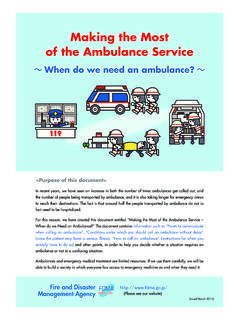Transcription of The Ministry of Health, Labour and Welfare …
1 The Ministry of Health, Labour andWelfare ministerial notification No. 519 Pursuant to Paragraph 1, Article 41 of the Pharmaceutical A airs Law (Law , 1960), we hereby revise a part of the Japanese Pharmacopoeia (MinisterialNoti cation No. 65, 2011) as follows*, and the revised Japanese Pharmacopoeia shallcome into e ect on October 1, 2012. However, in the case of drugs which are listed inthe Japanese Pharmacopoeia (hereinafter referred to as ``previous Pharmacopoeia'')[limited to those listed in the Japanese Pharmacopoeia whose standards are changedin accordance with this noti cation (hereinafter referred to as ``new Phar-macopoeia'')] and drugs which have been approved as of October 1, 2012 asprescribed under Paragraph 1, Article 14 of the law [including drugs the Minister ofHealth, Labour and Welfare speci es (the Ministry of Health and Welfare MinisterialNoti cation No.)]
2 104, 1994) as of September 30, 2012 as those exempted frommarketing approval pursuant to Paragraph 1, Article 14 of the law (hereinafterreferred to as ``drugs exempted from approval'')], the Name and Standards estab-lished in the previous Pharmacopoeia (limited to part of the Name and Standards forthe drugs concerned) may be accepted to conform to the Name and Standards estab-lished in the new Pharmacopoeia before and on March 31, 2014. In the case of drugswhich are listed in the new Pharmacopoeia (excluding those listed in the previousPharmacopoeia) and drugs which have been approved as of October 1, 2012 asprescribed under the Paragraph 1 of the same law (including those exempted from ap-proval), they may be accepted as those being not listed in the new Pharmacopoeia be-fore and on March 31, KomiyamaThe Minister of Health, Labour and WelfareSeptember 27, 2012(The text referred to by the term ``as follows'' are omitted here.
3 All of them are madeavailable for public exhibition at the Evaluation and Licensing Division, Pharmaceu-tical and Food Safety Bureau, Ministry of Health, Labour and Welfare , at eachRegional Bureau of Health and Welfare , and at each Prefectural Office in Japan).*The term ``as follows'' here indicates the content of Supplement I to the Japanese Pharmacopoeia Six-teenth Edition from General Notice to Ultraviolet-visible Reference Spectra (pp. 2321 2545). iSupplement I to The Japanese Pharmacopoeia,Sixteenth 2545 General Notices .. 2321 General Rules for Crude Drugs .. 2323 General Rules for Preparations .. 2325 General Tests, Processes and Apparatus .. Osmolarity Optical Rotation Determination .. Mass Spectrometry .. Inductively Coupled Plasma-AtomicEmission Spectrometry and Induc-tively Coupled Plasma-Mass Determination of Bulk and Bacterial Endotoxins Test.
4 Dissolution Reference Standards .. Standard Solutions .. Reagents, Test Solid Supports/Column Packings 2358O cial 2359 Crude 2495 Infrared Reference 2538 Ultraviolet-visible Reference 2545 General InformationG1 Physics and ChemistryInductively Coupled Plasma AtomicEmission 2547 Near Infrared 2547G2 Solid-state PropertiesMeasurement of the Diameter of Parti-clesDispersedinLiquidbyDyanamicLig ht Scattering .. 2551 Water-Solid Interactions: Determina-tion of Sorption-Desorption Iso-therms and of Water Activity .. 2554G3 Biotechnological/Biological ProductsMass Spectrometry of Peptides andProteins .. 2556G4 MicroorganismsMicrobiological Environmental Moni-toring Methods of Processing Areasfor Sterile Pharmaceutical Products(Former name: Microbiological Eva-luation of Processing Areas forSterile Pharmaceutical Products).
5 2558G5 Crude DrugsQuantitative Analytical Technique Uti-lizing Nuclear Magnetic Resonance(NMR) Spectroscopy and Its Applica-tion to Reagents in the 2564G8 WaterQuality Control of Water for Phar-maceutical Use .. OthersInternational Harmonization Imple-mented in the Japanese Pharma-copoeia Sixteenth Edition .. 2587 Index in Latin 2605 Index in 2607iiPREFACEThe 16th Edition of the Japanese Pharmacopoeia(JP) was promulgated by ministerial notification of the Ministry of Health, Labour and Welfare (MHLW) on March 24, July 2011, the Committee on JP established thebasic principles for the preparation of the JP 17th Edi-tion, setting out the roles and characteristics of the JP,the definite measures for the revision, and the date ofthe the Committee, the five basic principles of JP,which we refer to as the ``five pillars'', were estab-lished as follows: 1) Including all drugs which are im-portant from the viewpoint of health care and medicaltreatment; 2) Making qualitative improvement by in-troducing the latest science and technology; 3)Promoting internationalization.
6 4) Making promptpartial revision as necessary and facilitating smoothadministrative operation; and 5) Ensuring transparen-cy regarding the revision, and disseminating the JP tothe public. It was agreed that the Committee on JPshould make efforts, on the basis of these principles,to ensure that the JP is used more effectively in thefields of health care and medical treatment by takingappropriate measurements, including getting the un-derstanding and cooperation of other parties was agreed that the JP should provide an officialstandard, being required to assure the quality of medi-cines in Japan in response to the progress of scienceand technology and medical demands at the time. Itshould define the standards for specifications, as wellas the methods of testing to assure overall quality ofall drugs in principle, and it should have a role inclarifying the criteria for quality assurance of drugsthat are recognized to be essential for public healthand medical JP has been prepared with the aid of theknowledge and experience of many professionals inthe pharmaceutical field.
7 Therefore, the JP shouldhave the characteristics of an official standard, whichmight be widely used by all parties concerned, and itshould play an appropriate role of providing informa-tion and understanding about the quality of drugs tothe public. Moreover, as a pharmaceutical qualitystandard, it should contribute promoting and main-taining of advancedness as well as international con-sistency and harmonization of technical requirementsin the international was also agreed that JP articles should coverdrugs, which are important from the viewpoint ofhealth care and medical treatment, clinical perfor-mance or merits and frequency of use, as soon as pos-sible after they reach the target date for the publication of JP 17th Edi-tion (the Japanese edition) was set as April Expert Committees are organized with the fol-lowing committees: Expert Committee; Sub-expertCommittee; Committee on Chemicals; Committee onAntibiotics; Committee on Biologicals; Committee onCrude Drugs; Committee on Pharmaceutical Ex-cipients; Committee on Physico-Chemical Methods;Committee on Drug Formulation.
8 Committee onPhysical Methods; Committee on Biological Methods;Committee on Nomenclature for Pharmaceuticals;Committee on International Harmonization; Commit-tee on Pharmaceutical Water; and Committee onReference Standards. Furthermore, working groupsareestablishedundertheCommitteeonP hysico-Chemical Methods, Committee on Drug Formulationand Committee on Biological Methods to expedite dis-cussion on revision the Committee on JP, Takao Hayakawa took therole of chairman from July 2003 to December 2010,and Mitsuru Hashida from January 2011 to Septem-ber addition to the regular revision every five years inline with the basic principles for the preparation of theJP it was agreed that partial revision should be done asnecessary to take account of recent progress of scienceand in the interests of international accordance with the above principles, the com-mittees initiated deliberations on selection of articlesand on revisions for General Notices, General Rulesfor Crude Drugs, General Rules for Preparations,General Tests.
9 Monographs and so revisions covering subjects in General No-tices, General Rules for Crude Drugs, General Rulesfor Preparations, General Tests and Monographs, forwhich discussions were finished between April 2010and March 2012, were prepared for a supplement tothe JP 16. They were examined by the Committee onJP in May 2012, followed by the Pharmaceutical Af-fairs and Food Sanitation Council (PAFSC) in June2012, and then submitted to the Minister of Health, Labour and of discussions in the committees to pre-iiiiSupplement I, JP XVIP refacepare the supplement drafts were as follows: ExpertCommittee (8); Sub-expert Committee (4), Committeeon Chemicals (22), Committee on Antibiotics (5);Committee on Biologicals (9); Committee on CrudeDrugs (21); Committee on Pharmaceutical Excipients(12); Committee on Physico-Chemical Methods (14);Committee on Drug Formulation (19); Committee onPhysical Methods (7); Committee on BiologicalMethods (13); Committee on Nomenclature for Phar-maceuticals (7); Committee on International Har-monization (8); and Committee on PharmaceuticalWater (7).
10 It should be noted that in the preparation of thedrafts for the supplement, generous cooperation wasgiven by the Pharmaceutical Technology Committeeof the Osaka Pharmaceutical Manufacturers Associa-tion, the Pharmacopeia and CMC Committee of thePharmaceutical Manufacturer's Association ofTokyo, the Tokyo Crude Drugs Association, the In-ternational Pharmaceutical Excipients Council Japan,the Japan Kampo Medicines Manufacturers Associa-tion, the Japan Flavor and Fragrance Materials As-sociation, the Japan Medical Plants Federation, theJapan Pharmaceutical Manufacturers Association,the Parenteral Drug Association Japan Chapter, theJapan Reagent Association, the Japan Oilseeds Proc-essors Association, the Home Medicine Association ofJapan, and the Association of Membrane SeparationTechnology of consequence of this revision, the JP 16th Editioncarries 1837 articles, owing to the addition of 77 arti-cles and the deletion of 4 principles of description and the salient pointsof the revision in this volume are as Supplement I to JP 16th Edition comprisesthe following items, in order: notification of MHLW;Contents; Preface; General Notices; General Rules forCrude Drugs; General Rules for Preparations; Gener-al Tests, Processes and Apparatus; Official Mono-graphs; then followed by Infrared Reference Spectraand Ultraviolet-visible Reference Spectra; General In-formation.

















